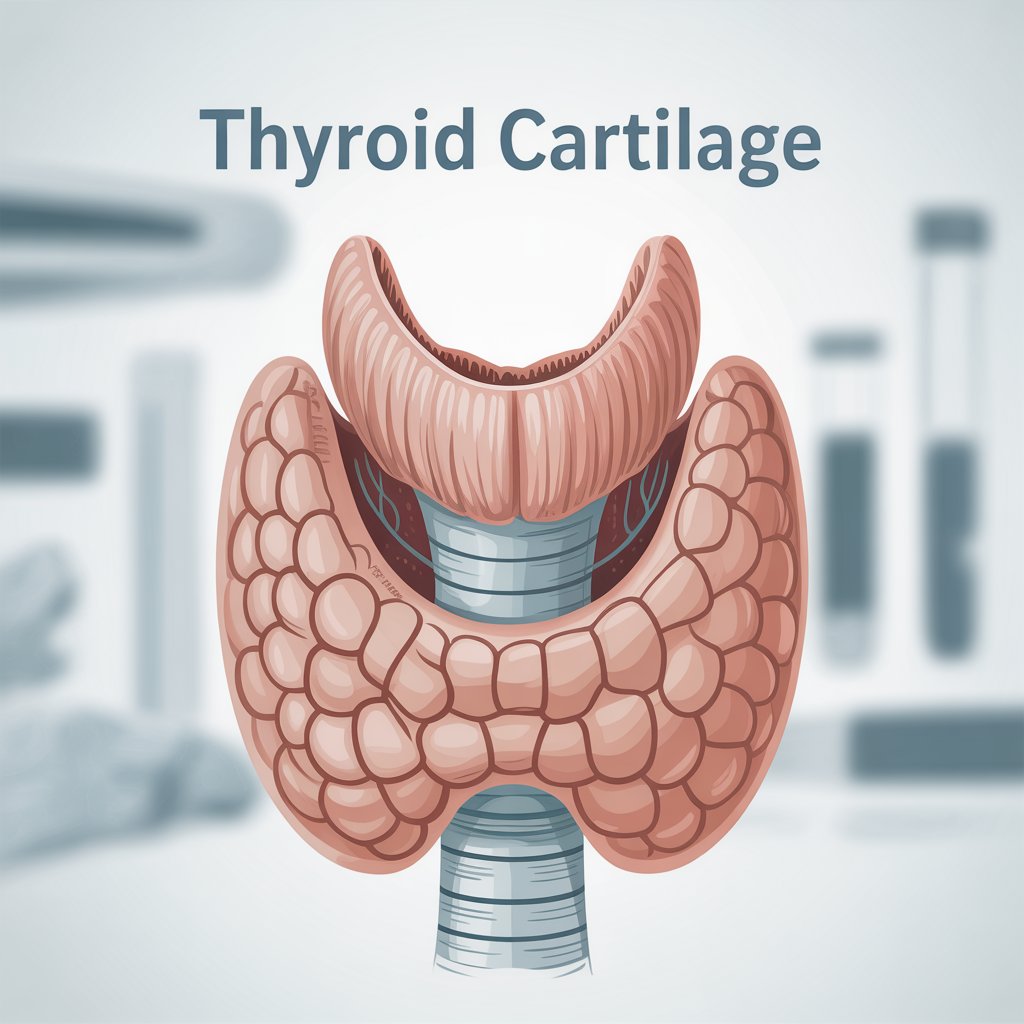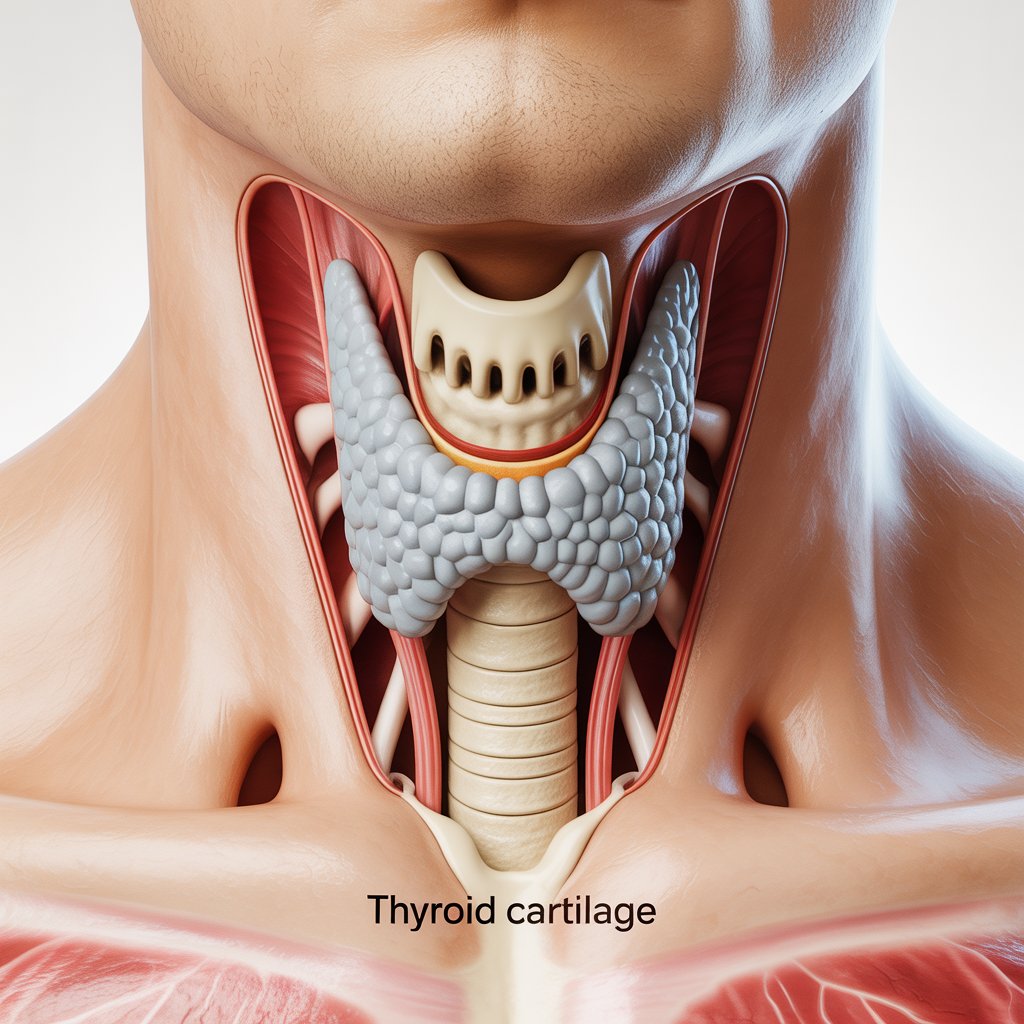Ever noticed the small bump in the middle of your neck, often called the Adam’s Apple? That’s the thyroid cartilage—the largest cartilage of the larynx (voice box). It doesn’t just shape the neck; it also plays a vital role in breathing, swallowing, and producing your voice.
In this article, we’ll break down the anatomy of the thyroid cartilage, explain its role in voice production, and look at its clinical importance.

Anatomy of the Thyroid Cartilage
As a whole, the thyroid cartilage has two surfaces (internal and external) and three borders/margins (superior, inferior and posterior). It is comprised of two identical flat parts known as the thyroid laminae. These are fused anteriorly along the midline to form a subcutaneous elevation known as the laryngeal prominence. In females, the laminae meet at an angle of approximately 120 degrees while in males, the angle is more acute at around 90 degrees. This smaller thyroid angle explains the more pronounced laryngeal prominence seen in males (the ‘Adam’s apple’), longer vocal cords, and lower-pitched voice in males.
Along the superior border of the thyroid cartilage, the two laminae are separated by a V-shaped triangular space called the superior thyroid notch. A smaller, more shallow inferior thyroid notch can sometimes be appreciated in the middle of the lower border.
The posterior borders of the thyroid laminae elongate into superior and inferior projections known as the thyroid horns. The superior thyroid horn is longer and narrower than its inferior counterpart and is directed superiorly and posteromedially. Together with the entire superior margin of the thyroid cartilage, the superior horn is attached to the hyoid bone by the thyrohyoid membrane.
In contrast, the inferior thyroid horn is shorter and thicker and directed inferiorly and anteromedially. The inferior horn carries a small articular facet that articulates with the thyroid articular facet on the lateral side of the cricoid cartilage and forms the cricothyroid joint.
The superior thyroid tubercle is located anterior to the root of the superior horn, while the inferior tubercle is located on the inferior border of the thyroid lamina. Running anteroinferiorly between these landmarks on the external surface of each lamina is a ridge known as the oblique line. This serves as the attachment point for the sternothyroid, thyrohyoid, and thyropharyngeal part of the inferior pharyngeal constrictor muscle.
The angle serves as the attachment point for several laryngeal ligaments and muscles, such as the thyroepiglottic, vestibular, and vocal ligaments as well as the thyroarytenoid, thyroepiglottic, and vocalis muscles.
Location & Relationships:
- Sits in front of the vocal cords, offering them protection.
- Forms part of the voice box along with the cricoid and arytenoid cartilages.

Role in Voice Production
The thyroid cartilage isn’t just a shield—it’s a key player in sound production.
- It protects the vocal cords inside the larynx.
- Works with the cricothyroid muscle to adjust the tension of the vocal cords, changing the pitch of the voice.
- Its movement helps create different tones and sounds when we speak or sing.
In simple terms: Without the thyroid cartilage, your voice wouldn’t sound the same!
Functions of the Thyroid Cartilage
The thyroid cartilage has several functions.
According to researchTrusted Source, the primary function of the thyroid cartilage is to protect the airways from damage or injury, especially the vocal cords, which attach to the back side of the thyroid cartilage.
The thyroid cartilage performs this function with other parts of the larynx cartilage. These include the following structures:
- cricoid cartilage
- arytenoid cartilages
- corniculate, cuneiform, and tritiate cartilages
- the epiglottitis
The laryngeal cartilages help form the framework to which the vocal cords and the muscles around them attach.
Common Disorders Related to Thyroid Cartilage
While rare, some conditions can affect the thyroid cartilage:
- Fractures or Injuries – Usually due to trauma to the neck.
- Calcification – Over time, especially in older adults, it may become harder and less flexible.
- Inflammation or Tumors – Though uncommon, infections or growths can affect its function.
Conclusion
frequently asked question
The thyroid cartilage forms a visible bump in the neck known as the Adam’s Apple. It’s more prominent in men because testosterone causes the cartilage to grow larger and protrude more during puberty.
Its primary role is to protect the vocal cords and support the larynx. It also helps in modulating voice pitch by working with the cricothyroid muscles.
Yes, trauma to the neck (e.g., in accidents or sports injuries) can cause fractures or damage to the thyroid cartilage, potentially affecting breathing and voice.



